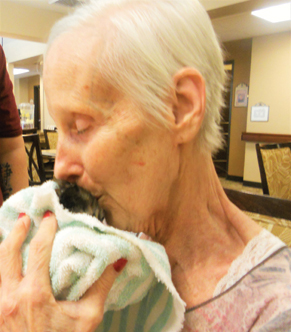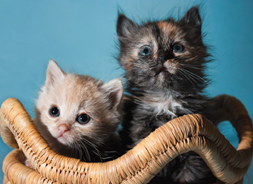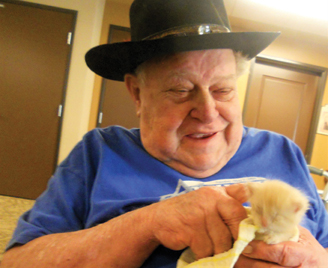At Catalina Springs Memory Care, Health Service Director Rebecca Hamilton and her team are thinking outside of the box, and that box has kittens in it. The Arizona-based facility has introduced a program that brings in orphaned kittens for residents to care for, and it has succeeded “beyond our wildest dreams,” Hamilton says.

The program evolved from a staff meeting where the team was looking for innovative ideas. “I have a relationship with the Pima Animal Care Center here and have fostered kittens myself, so I thought it would be a good fit. Everyone was enchanted with the idea and very supportive,” says Hamilton. She contacted the animal care center, and the response was immediate. “The partnership was formed, and in 12 hours, they said, ‘We have the perfect two kittens for the pilot project.’”
From the start, the residents took the project seriously. “They realize that this is important work—that they are saving these kittens’ lives,” says Hamilton. “They would feed them, burp them, rock them, and hold them,” she says. Until the kittens were old enough to use a litter box (they were two weeks old when they came to the facility), the residents “understood the need to pat their bottoms to get them to void.”
Pets And People: A Perfect Partnership
The presence of the kittens has had an almost magical effect on people at the facility. “People talk more, and they’re happier,” Hamilton says. Residents are more engaged.
For example, she observes, “We have one older woman with memory impairments who, after caring for the kittens, has started to talk about growing up on a farm and having 19 cats in the barn. The more she cared for the kittens, the more memories came back.”
Hamilton notes that the act of caring seems to have unlocked memories for many of the residents. “They started talking about their children or about pets they had as kids. It’s really been astonishing.”
The kittens also have enhanced caregiver-resident relations. Hamilton recalls, “I overheard a caregiver talking with some residents. They were chatting about the kittens—which one was their favorite, what would be good names for them, and so on. They are working together on this project, and it puts them on the same level and gives them a common purpose.”
From day one, Hamilton says, the residents smiled more and became more engaged. “We would see residents who were normally withdrawn became animated. We witnessed a resident who often was gruff be very gentle and tender.” She says, “This was always a nice, positive place, but it’s even better, happier because of these two little balls of fur. It’s been an extraordinary experience.”
Making The Commitment
It doesn’t take a huge investment of time, money, or expertise for such a project, says Hamilton. However, it is necessary to have a champion—a point-person who can keep the effort on track and attend to all of the
details. Ideally, this person is an animal lover who has experience raising kittens. However, she says, “This person can get training from experts at the local shelter or rescue organization and teach these skills
to others.”

Staff will need to mix formula and prepare bottles for feeding and ensure that someone is responsible for overnight feedings when residents are asleep. Hamilton points out that when kittens are very small, they will need to be fed every few hours around the clock.
At the same time, someone needs to be responsible for cleaning the litter box and making sure that the facility has all of the necessary supplies to keep the kittens healthy and happy. “We have a dog crate in my office that has blankets and toys. The kittens sleep in there,” Hamilton says. She also keeps a makeshift litter box—a baking pan filled with wheat or corn litter to avoid the dust and mess of clay products.
Hamilton stresses the importance of ensuring that the kittens are free of fleas and ringworm before they come to the facility and that they are treated accordingly. “This should be part of the agreement up front,” she says. Otherwise, kittens are very clean and safe for residents to interact with, she says, noting that keeping claws trimmed is an additional safety precaution.
What Happens Next
While it is true that not everyone is a cat lover, Hamilton says that there hasn’t been one complaint about the kittens. Residents, family members, and staff alike are pleased with the project and what it has accomplished. They take pictures and post them, along with praise for the program, on social media. The project also has generated media coverage and resulted in positive national attention for the facility.

Of course, nothing good lasts forever, and the kittens will soon be spayed/neutered and put up for adoption. But thanks to the residents’ extraordinary efforts, Hamilton is confident that they will find good homes and be great pets.
“We’ve emphasized to the residents that these babies will have wonderful homes waiting for them, and their new families will be so happy that you’ve raised them,” she says. “They take great pride in that.”
While everyone must say goodbye to these kittens, there definitely will be more in the facility’s future.
“It truly is a win-win situation,” Hamilton says. “Our local shelter has over 2,100 kittens come through every year, and unless someone steps forward to provide fostering and care, they don’t stand a chance. Our residents have so much love and nurturing to give. It is a natural fit.”
Joanne Kaldy is a freelance writer and communications consultant based in Harrisburg, Pa.